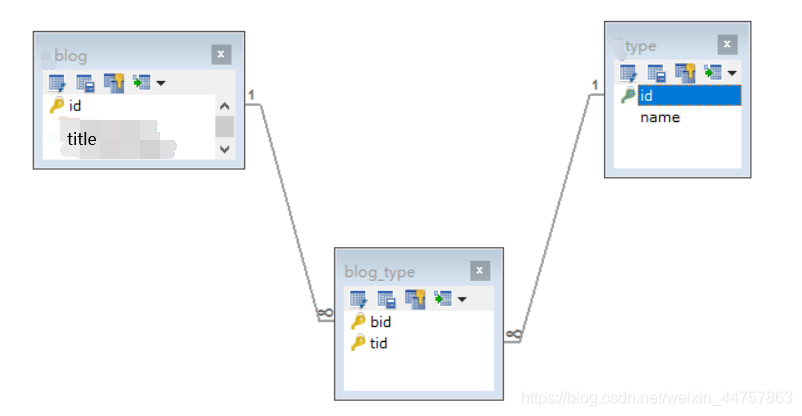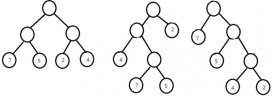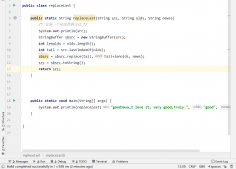批量添加一对多中间表
建立中间表A,一个id对应多个lid;
传入两条参数
|
1
2
|
long id;//单个数值List lid;//集合数值 |
dao层语句
|
1
|
int insertb(@Param("id")long id,@Param("lid")List lid); |
mybatis中的写法
|
1
2
3
4
|
insert into A(id,lid) values <foreach collection="lid" item="data" separator=","> (#{id},#{data}) </foreach> |
多对多条件下插入中间表(使用insert标签的属性)
说下需求
我的数据库中有两张表,一张是Blog表,一张是Type表,分别代表了博客和博客类别,它们之间是多对多关系,它们由一张中间表blog_type维护。
(简单起见,blog表只有两个数据,id和title。type表只有id和name)

那么需求就是:
现在我想插入一条Blog数据,因为blog和type是多对多关系,想插入其中一个数据,就得维护他们之间那个中间表blog_type的关系(插入中间表字段)。
解决方案
那么我能想到的解决方案是:
写两段insert标签,第一段sql语句插入blog表,第二段sql语句插入insert表:
|
1
2
3
4
5
6
7
|
<insert id="insertBlogWithoutType" parameterType="blog"> insert into t_blog (title) values (#{title});</insert><insert id="insertBlog_Type"> insert into blog_type (bid, tid) values(#{blog.id},#{type.id})</insert> |
但是这么做会有它的问题
由于blog表id为自增,所以我并没有插入id。如何在第二个insert查询语句中获取刚刚插入的id呢?
经过多方查找我发现了解决方案:
要用到MyBatis中insert标签的三个属性:
-
useGeneratedKeys(仅对 insert 和 update 有用)这会令 MyBatis 使用 JDBC 的 getGeneratedKeys 方法来取出由数据库内部生成的主键(比如:像 MySQL 和 SQL Server 这样的关系数据库管理系统的自动递增字段),默认值:false。 -
keyProperty(仅对 insert 和 update 有用)唯一标记一个属性,MyBatis 会通过 getGeneratedKeys 的返回值或者通过 insert 语句的 selectKey 子元素设置它的键值,默认:unset。如果希望得到多个生成的列,也可以是逗号分隔的属性名称列表。 -
keyColumn(仅对 insert 和 update 有用)通过生成的键值设置表中的列名,这个设置仅在某些数据库(像 PostgreSQL)是必须的,当主键列不是表中的第一列的时候需要设置。如果希望得到多个生成的列,也可以是逗号分隔的属性名称列表。
重新生成的代码如下所示:
|
1
2
3
4
5
6
7
|
<insert id="insertBlogWithoutType" parameterType="blog" useGeneratedKeys="true" keyProperty="id" keyColumn="id"> insert into t_blog (title) values (#{title});</insert><insert id="insertBlog_Type"> insert into blog_type (bid, tid) values(#{blog.id},#{type.id})</insert> |
注意!keyProperty是Java对象的属性名!不是数据库表中字段名!
测试
编写Dao层
|
1
2
3
|
//分成两个方法,但是他们两个将在Service层合二为一 int insertBlogWithoutType(Blog blog); int insertBlog_Type(@Param("blog")Blog blog, @Param("type")Type type); |
Dao层就是对应的前面mapper文件里的两个方法
Service层
|
1
2
3
4
5
6
|
public void insertBlog(Blog blog, List<Type> types) { blogDao.insertBlogWithoutType(blog); for (Type type : types) { blogDao.insertBlog_Type(blog, type); } } |
这里的意思是,先插入一个传进来的blog(第一个参数)。然后插入之后根据插进来的blog的主键(blog的id)和传入的type的主键(type的id),插入中间表。
Test类
|
1
2
3
4
5
6
7
8
9
10
11
12
13
14
|
@Test public void test2(){ ApplicationContext context = new ClassPathXmlApplicationContext("applicationContext.xml"); BlogService blogServiceImpl = (BlogService) context.getBean("BlogServiceImpl"); //设置blog Blog blog = new Blog(); blog.setTitle("【MyBatis】多对多条件下插入中间表(使用insert标签的属性)"); //设置该blog对应的type List<Type> types = new ArrayList<Type>(); types.add(new Type(1,"数据库")); types.add(new Type(2,"Debug专题")); blogServiceImpl.insertBlog(blog, types); } |
可以看到,设置blog的时候,并没有设置blog的id属性,但是调用insertBlog时,插入中间表却已经知道了blog的id属性。这就是MyBatis中insert标签的三个属性的作用了!
执行完上面的代码,数据库里既插入了一条新的blog,又维护了他们之间那个中间表blog_type的关系(插入了中间表),至此问题解决。
以上为个人经验,希望能给大家一个参考,也希望大家多多支持服务器之家。
原文链接:https://blog.csdn.net/whwwycl/article/details/92803335














